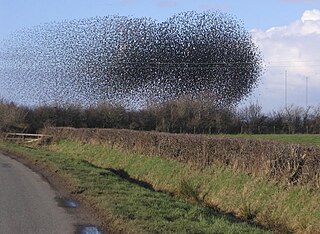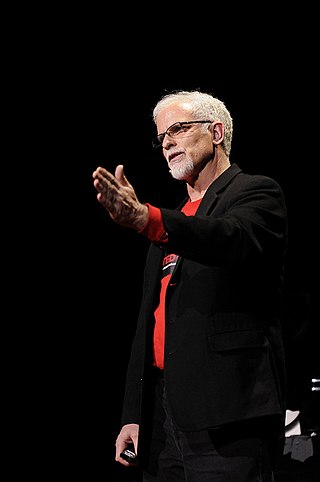Related Research Articles

In condensed matter physics, a Bose–Einstein condensate (BEC) is a state of matter that is typically formed when a gas of bosons at very low densities is cooled to temperatures very close to absolute zero. Under such conditions, a large fraction of bosons occupy the lowest quantum state, at which microscopic quantum-mechanical phenomena, particularly wavefunction interference, become apparent macroscopically. More generally, condensation refers to the appearance of macroscopic occupation of one or several states: for example, in BCS theory, a superconductor is a condensate of Cooper pairs. As such, condensation can be associated with phase transition, and the macroscopic occupation of the state is the order parameter.
Unconventional superconductors are materials that display superconductivity which does not conform to conventional BCS theory or its extensions.
Metallic hydrogen is a phase of hydrogen in which it behaves like an electrical conductor. This phase was predicted in 1935 on theoretical grounds by Eugene Wigner and Hillard Bell Huntington.
In condensed matter physics, a quasiparticle is a concept used to describe a collective behavior of a group of particles that can be treated as if they were a single particle. Formally, quasiparticles and collective excitations are closely related phenomena that arise when a microscopically complicated system such as a solid behaves as if it contained different weakly interacting particles in vacuum.

Mott insulators are a class of materials that are expected to conduct electricity according to conventional band theories, but turn out to be insulators. These insulators fail to be correctly described by band theories of solids due to their strong electron–electron interactions, which are not considered in conventional band theory. A Mott transition is a transition from a metal to an insulator, driven by the strong interactions between electrons. One of the simplest models that can capture Mott transition is the Hubbard model.

Bismuth strontium calcium copper oxide (BSCCO, pronounced bisko), is a type of cuprate superconductor having the generalized chemical formula Bi2Sr2Can−1CunO2n+4+x, with n = 2 being the most commonly studied compound (though n = 1 and n = 3 have also received significant attention). Discovered as a general class in 1988, BSCCO was the first high-temperature superconductor which did not contain a rare-earth element.
In physics, quantum acoustics is the study of sound under conditions such that quantum mechanical effects are relevant. For most applications, classical mechanics are sufficient to accurately describe the physics of sound. However very high frequency sounds, or sounds made at very low temperatures may be subject to quantum effects.

Angle-resolved photoemission spectroscopy (ARPES) is an experimental technique used in condensed matter physics to probe the allowed energies and momenta of the electrons in a material, usually a crystalline solid. It is based on the photoelectric effect, in which an incoming photon of sufficient energy ejects an electron from the surface of a material. By directly measuring the kinetic energy and emission angle distributions of the emitted photoelectrons, the technique can map the electronic band structure and Fermi surfaces. ARPES is best suited for the study of one- or two-dimensional materials. It has been used by physicists to investigate high-temperature superconductors, graphene, topological materials, quantum well states, and materials exhibiting charge density waves.
Inelastic electron tunneling spectroscopy (IETS) is an experimental tool for studying the vibrations of molecular adsorbates on metal oxides. It yields vibrational spectra of the adsorbates with high resolution (< 0.5 meV) and high sensitivity (< 1013 molecules are required to provide a spectrum). An additional advantage is the fact that optically forbidden transitions may be observed as well. Within IETS, an oxide layer with molecules adsorbed on it is put between two metal plates. A bias voltage is applied between the two contacts. An energy diagram of the metal-oxide-metal device under bias is shown in the top figure. The metal contacts are characterized by a constant density of states, filled up to the Fermi energy. The metals are assumed to be equal. The adsorbates are situated on the oxide material. They are represented by a single bridge electronic level, which is the upper dashed line. If the insulator is thin enough, there is a finite probability that the incident electron tunnels through the barrier. Since the energy of the electron is not changed by this process, it is an elastic process. This is shown in the left figure.

A topological insulator is a material whose interior behaves as an electrical insulator while its surface behaves as an electrical conductor, meaning that electrons can only move along the surface of the material.

Active matter is matter composed of large numbers of active "agents", each of which consumes energy in order to move or to exert mechanical forces. Such systems are intrinsically out of thermal equilibrium. Unlike thermal systems relaxing towards equilibrium and systems with boundary conditions imposing steady currents, active matter systems break time reversal symmetry because energy is being continually dissipated by the individual constituents. Most examples of active matter are biological in origin and span all the scales of the living, from bacteria and self-organising bio-polymers such as microtubules and actin, to schools of fish and flocks of birds. However, a great deal of current experimental work is devoted to synthetic systems such as artificial self-propelled particles. Active matter is a relatively new material classification in soft matter: the most extensively studied model, the Vicsek model, dates from 1995.
Juan Carlos Campuzano is a Paraguayan American physicist. He is a Distinguished Professor of Physics at the University of Illinois at Chicago. He was a Distinguished Fellow at Argonne National Laboratory, and a he is also a 2001 American Physical Society Fellow and a recipient of the 2011 Oliver Buckley Prize in Condensed Matter Physics. He is an expert in high-temperature superconductivity.
Philippe Guyot-Sionnest is a professor at the University of Chicago appointed jointly in the departments of physics and chemistry. He works in the field of colloidal semiconductors and metal nanocrystals.

Michael Lee Roukes is an American experimental physicist, nanoscientist, and the Frank J. Roshek Professor of Physics, Applied Physics, and Bioengineering at the California Institute of Technology (Caltech).
Quantum anomalous Hall effect (QAHE) is the "quantum" version of the anomalous Hall effect. While the anomalous Hall effect requires a combination of magnetic polarization and spin-orbit coupling to generate a finite Hall voltage even in the absence of an external magnetic field, the quantum anomalous Hall effect is its quantized version. The Hall conductivity acquires quantized values proportional to integer multiples of the von Klitzing constant. In this respect the QAHE is similar to the quantum Hall effect. The integer here is equal to the Chern number which arises out of topological properties of the material band structure. These effects are observed in systems called quantum anomalous Hall insulators.

Xue Qikun is a Chinese physicist. He is a professor of Tsinghua University, Beijing. He has done much work in Condensed Matter Physics, especially on superconductors and topological insulators. In 2013, Xue was the first to achieve the quantum anomalous Hall effect (QAHE), an unusual orderly motion of electrons in a conductor, in his laboratory at Tsinghua University. Xue is a member of the Chinese Academy of Sciences, vice president for research of Tsinghua University, and director of State Key Lab of Quantum Physics. In 2016, he was one of the first recipients of the new Chinese Future Science Prize for experimental discovery of high-temperature superconductivity at material interfaces and the QAHE. This award has been described as "China's Nobel Prize".

Alessandra Lanzara is an Italian-American physicist and the distinguished Charles Kittel Professor of physics at the University of California, Berkeley since 2002, where she leads an experimental materials physics group. She is the founding director of Center for Sustainable Innovation at UCB and the co-founder of Quantum Advanced Detection (QUAD) LLC.

Phase separation is the creation of two distinct phases from a single homogeneous mixture. The most common type of phase separation is between two immiscible liquids, such as oil and water. This type of phase separation is known as liquid-liquid equilibrium. Colloids are formed by phase separation, though not all phase separations forms colloids - for example oil and water can form separated layers under gravity rather than remaining as microscopic droplets in suspension.
Pablo Jarillo-Herrero is a Spanish physicist and current Cecil and Ida Green Professor of Physics at Massachusetts Institute of Technology (MIT).
Vidya Madhavan is an Indian American physicist who is Professor of Condensed Matter at the University of Illinois Urbana-Champaign. Her research considers the spin and charge of quantum materials. She combines high resolution characterization techniques with precise fabrication and growth techniques. She was elected Fellow of the American Physical Society in 2015.
References
- ↑ "封东来". faculty.ustc.edu.cn (in Chinese). Retrieved 2024-05-30.
- ↑ "中国科学院2021年院士增选名单揭晓". www.people.cn (in Chinese). 2021-11-18. Retrieved 2024-05-30.
- ↑ "ShanghaiTech University announces leadership changes". 2024-06-05. Retrieved 2024-06-25.
- ↑ "Prof. Dong-Lai Feng Achieves Javed Husain Prize_English_复旦大学". news.fudan.edu.cn. Retrieved 2016-02-05.
- ↑ "AAA Award (ROBERT T. POE PRIZE) | OCPA". ocpaweb.org. Retrieved 2016-02-05.
- ↑ Lanzara, A.; Bogdanov, P. V.; Zhou, X. J.; Kellar, S. A.; Feng, D. L.; Lu, E. D.; Yoshida, T.; Eisaki, H.; Fujimori, A. (2001-08-02). "Evidence for ubiquitous strong electron–phonon coupling in high-temperature superconductors". Nature. 412 (6846): 510–514. arXiv: cond-mat/0102227 . doi:10.1038/35087518. ISSN 0028-0836. PMID 11484045.
- ↑ Ronning, F.; Kim, C.; Feng, D. L.; Marshall, D. S.; Loeser, A. G.; Miller, L. L.; Eckstein, J. N.; Bozovic, I.; Shen, Z.-X. (1998-12-11). "Photoemission Evidence for a Remnant Fermi Surface and a d-Wave-Like Dispersion in Insulating Ca2CuO2Cl2". Science. 282 (5396): 2067–2072. arXiv: cond-mat/9903151 . Bibcode:1998Sci...282.2067R. doi:10.1126/science.282.5396.2067. ISSN 0036-8075. PMID 9851925.
- ↑ Feng, D. L.; Lu, D. H.; Shen, K. M.; Kim, C.; Eisaki, H.; Damascelli, A.; Yoshizaki, R.; Shimoyama, J.-i; Kishio, K. (2000-07-14). "Signature of Superfluid Density in the Single-Particle Excitation Spectrum of Bi2Sr2CaCu2O8+δ". Science. 289 (5477): 277–281. arXiv: cond-mat/0009306 . Bibcode:2000Sci...289..277F. doi:10.1126/science.289.5477.277. ISSN 0036-8075. PMID 10894771.
- ↑ Shen, Z.-X.; White, P. J.; Feng, D. L.; Kim, C.; Gu, G. D.; Ikeda, H.; Yoshizaki, R.; Koshizuka, N. (1998-04-10). "Temperature-Induced Momentum-Dependent Spectral Weight Transfer in Bi2Sr2CaCu2O8+δ". Science. 280 (5361): 259–262. Bibcode:1998Sci...280..259S. doi:10.1126/science.280.5361.259. ISSN 0036-8075. PMID 9535649.